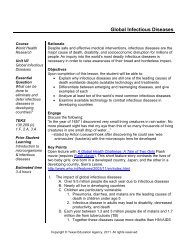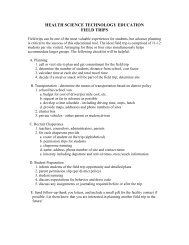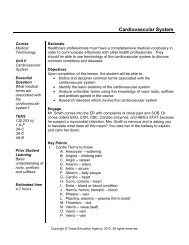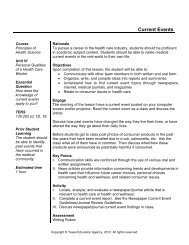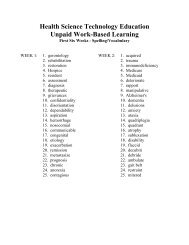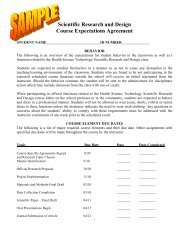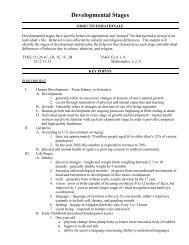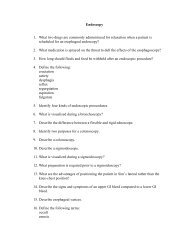Public Health: An Introduction - Texas Health Science!
Public Health: An Introduction - Texas Health Science!
Public Health: An Introduction - Texas Health Science!
Create successful ePaper yourself
Turn your PDF publications into a flip-book with our unique Google optimized e-Paper software.
1. causes of diseases/injury2. risks of specified diseases or injuries3. which populations are at risk for specific diseases/injuries4. methods to prevent further health incidentsC. biostatistics are often used in conjunction with epidemiology topredict and track disease trendsVIII. <strong>Health</strong> Services Administration / ManagementA. combines business and science in the managing of humanand monetary resources needed to deliver effective publichealth servicesB. specializes in planning and organization of policies;responsible for analysis, finance, economics, and marketing ofhealth servicesIX. Maternal and Child <strong>Health</strong>A. provides information and access to birth controlB. promotes health of pregnant women and unborn childC. improves public health delivery systems specifically for womenand children through advocacy, education, and researchX. NutritionA. field examines how food and nutrients affect wellness andlifestyle of populationB. sponsors healthy eating and exercise awarenessC. educates community about dangers of both obesity and overdietingXI. <strong>Public</strong> <strong>Health</strong> Laboratory PracticeA. laboratory professionals (microbiologists, biochemists,pathologists) who test biological and environmental samples inorder to help diagnose prevent, treat, and control diseases incommunitiesB. ensure safety of public food and waterC. screen for presence of certain diseases within communitiesD. respond to public health emergencies (e.g. infectious diseaseoutbreaks, bioterrorism)XII. <strong>Public</strong> <strong>Health</strong> PolicyA. works to improve the public’s health through legislation at local,state, and federal levelsB. example: seat belt lawsXIII. Global (International) <strong>Health</strong>A. global public health professionals who address health concernsamong different cultures around the world1. works towards health challenges that transcend nationalboundaries2. this international field encompasses virtually allspecializations of public healthB. Impact of <strong>Public</strong> <strong>Health</strong>1. Improvement of populations quality of lifeCopyright © <strong>Texas</strong> Education Agency, 2012. All rights reserved.
HandoutTwelve Principles of the Ethical Practice of <strong>Public</strong> <strong>Health</strong>http://www.ncbi.nlm.nih.gov/pmc/articles/PMC1447186/1. <strong>Public</strong> health should address principally the fundamental causes of disease andrequirements for health, aiming to prevent adverse health outcomes.2. <strong>Public</strong> health should achieve community health in a way that respects the rights ofindividuals in the community.3. <strong>Public</strong> health policies, programs, and priorities should be developed and evaluatedthrough processes that ensure an opportunity for input from community members.4. <strong>Public</strong> health should advocate for, or work for the empowerment of, disenfranchisedcommunity members, ensuring that the basic resources and conditions necessary forhealth are accessible to all people in the community.5. <strong>Public</strong> health should seek the information needed to implement effective policies andprograms that protect and promote health.6. <strong>Public</strong> health institutions should provide communities with the information they have thatis needed for decisions on policies or programs and should obtain the community'sconsent for their implementation.7. <strong>Public</strong> health institutions should act in a timely manner on the information they havewithin the resources and the mandate given to them by the public.8. <strong>Public</strong> health programs and policies should incorporate a variety of approaches thatanticipate and respect diverse values, beliefs, and cultures in the community.9. <strong>Public</strong> health programs and policies should be implemented in a manner that mostenhances the physical and social environment.10. <strong>Public</strong> health institutions should protect the confidentiality of information that can bringharm to an individual or community if made public. Exceptions must be justified on thebasis of the high likelihood of significant harm to the individual or others.11. <strong>Public</strong> health institutions should ensure the professional competence of their employees.12. <strong>Public</strong> health institutions and their employees should engage in collaborations andaffiliations in ways that build the public's trust and the institution's effectiveness.Copyright © <strong>Texas</strong> Education Agency, 2012. All rights reserved.
Teacher Notes:<strong>An</strong>d the Band Played OnThis powerful and insightful HBO movie is based on the non-fiction book written by theAmerican journalist and freelance reporter, Randy Shilts.The book was the first critical study of the history and development of the AIDS epidemic.The movie edited in actual news reports and documentary footage of authentic events thattook place during the early years of the AIDS epidemic.The film introduces students to public health professionals at the CDC. It shows the processpublic health professionals follow when identifying and tracking a disease. Students will alsoobserve the how the CDC researches as a team.The movie explores the political, religious, and social views of AIDS and homosexuals. Itexposes the government’s seemingly lack of interest in what was initially perceived as a “gaydisease”.Other insights include: the media’s initial apathy in AIDS, the slow response of blood banksto safeguard their supply, and the infighting that went on between major researchorganizations, all of which ultimately the failed to prevent the spread of AIDS plus impedefunding and research.The final memorial epilogue is also of great interest with actual video clips and pictures ofAIDS patients—gay, straight; old, young; men, women, and children. This last part helps toillustrate the breadth of the impact of the AIDS epidemic.The book and movie title, <strong>An</strong>d the Band Played On, is said to be in reference to the band onthe Titanic, who kept playing as the ship was sinking.Copyright © <strong>Texas</strong> Education Agency, 2012. All rights reserved.
Post-Movie Discussion Questions1. Why do you think that the gay population was living such an open, promiscuous lifestyleduring the 1980s?2. Why did the gay population disagree so vehemently against closing the bathhouses?3. Why did a legal battle ensue between Dr. Robert Gallo and the French research group?4. Why are AIDS infected people subject to opportunistic infections?5. Why was the blood bank hesitant in safeguarding their blood supply even though there wasevidence that it was probably infected with the AIDS virus?6. Why did the CDC have to use case-control studies and interviews to track AIDS instead ofusing the more accurate randomized study?7. When did the government & general population begin to show sensitivity and supporttowards AIDS?8. How did AIDS eventually get the political clout and support it has today?9. What do you think the title “<strong>An</strong>d the Band Played On” means?Copyright © <strong>Texas</strong> Education Agency, 2012. All rights reserved.
Name _______________________________ Period _________Date ___________Movie Questions: <strong>An</strong>d The Band Played On…DirectionsPlease provide short answers for these questions as you watch this film.1. In the movie’s prologue, what is the disease that Dr. Don Francis discovers in the Congo?2. What type of public health professional was Dr. Don Francis?3. What did the public health professionals mean by “shoe leather epidemiology”?4. Early in the AIDS epidemic, a study was done that demonstrated AIDS was a sexuallytransmitted disease. Where did most of the sexual liaisons take place?5. What acronym was originally given to the AIDS virus and what did that acronym stand for?6. What is the name of the dark skin lesions that many AIDS patients were developing?7. Who was the researcher who discovered the first retrovirus.8. Throughout the movie the epidemiologists reiterated that they must always do three thingsin order to properly identify a disease: 1) What do you _________? 2) What do you_________? 3) What can you _________?Copyright © <strong>Texas</strong> Education Agency, 2012. All rights reserved.
9. What do you think was meant by the boardroom question, “When doctors start acting likebusinessmen, who can the people turn to for doctors?”10. Why was it so difficult to get federal funding for AIDS research in the early years?11. Give at least 4 reasons why the AIDS virus spread so quickly.12. What is the name of the research clinic that was responsible for the definitive identificationof the AIDS virus?13. What did you learn from this movie about HIV/AIDS, public health, and the government thatyou did not know?Copyright © <strong>Texas</strong> Education Agency, 2012. All rights reserved.



